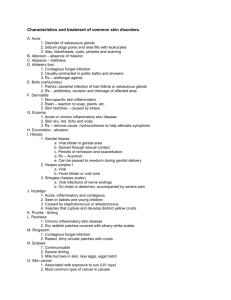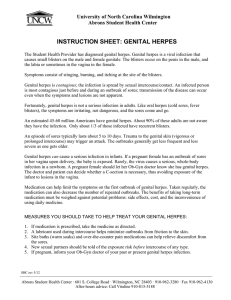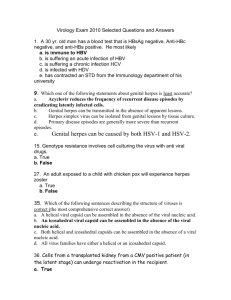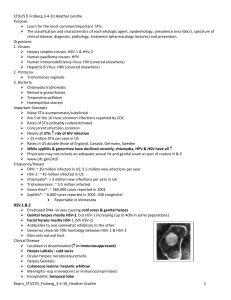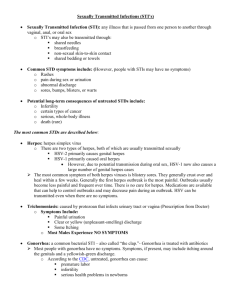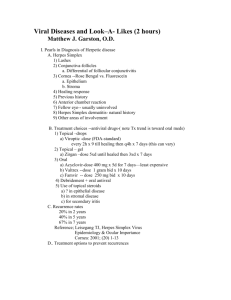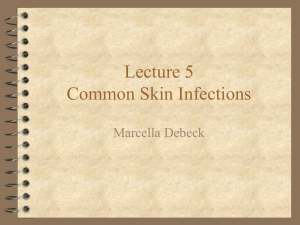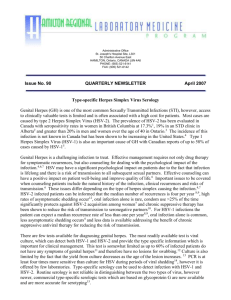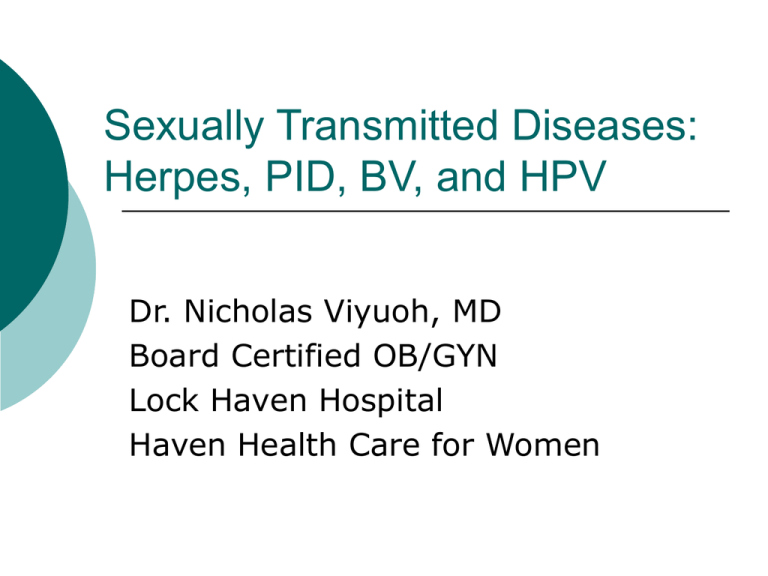
Sexually Transmitted Diseases:
Herpes, PID, BV, and HPV
Dr. Nicholas Viyuoh, MD
Board Certified OB/GYN
Lock Haven Hospital
Haven Health Care for Women
Herpes
What is it?
Herpes is a viral infection caused by Herpes
Simplex Virus.
There are 2 types of Herpes:
HSV 1 (oral), and HSV 2 (genital)
Signs/Symptoms
Burning/itching/tingling before an outbreak,
then painful ulcers will break out.
The first outbreak will typically occur 2 weeks
after infection, and last from 2-4 weeks.
Outbreaks can vary in severity and amount,
but they typically decline as people age.
Herpes
How common is it?
Herpes is one of the most common STDs.
1 in 4 women have genital herpes
1 in 5 men have genital herpes
How is it transmitted?
*statistics from the CDC*
Sexual contact, whether a sexual partner is
having an outbreak or not!
Complications:
HSV infection in pregnancy can result in
transmission to fetus, which can be fatal
(particularly if first outbreak during pregnancy)
An infection with HSV can make you more
susceptible to contracting HIV if exposed.
Herpes
Can herpes be treated?
Unlike other STDs, Herpes cannot be cured,
once infected, a person will never be free of
the virus. Treatment is to limit the number and
severity of outbreaks.
Herpes outbreaks can be limited with antiviral
drugs (Valtrex). Antiviral drugs can also help
to prevent transmission to sexual partners
Prevention:
Abstinence is the only absolute prevention
Condoms can help to reduce transmission, but
are not 100% effective
PID- Pelvic Inflammatory Disease
What is it?
What causes it?
Pelvic Inflammatory Disease is an infection and
inflammation of the uterus and/or fallopian
tubes.
Infection (untreated/undiagnosed) of
Gonorrhea and/or Chlamydia, or other types of
infection
Signs/Symptoms
Lower abdominal pain
Painful intercourse
Fever
Discharge
Burning with urination
PID
Complications?
How many women get it?
1 million women/year
100,000 women become infertile each year from PID
150 women die each year from PID or complications of PID
Treatment:
Infertility due to damage/scarring of reproductive tracts
Ectopic pregnancy: “tubal pregnancy” any pregnancy which
implants outside the uterus, a life threatening condition for
the mother!
Treat underlying cause (Gonorrhea/Chlamydia/BV)
Prevention:
Do not douche
Limit sexual partners
Get annual STD screening, or screenings with new partners
BV- Bacterial Vaginosis
What is it?
Signs/Symptoms
Vaginal discharge with odor (usually fishy)
Burning with urination, vaginal itching, pain
Some women are asymptomatic
What causes it?
Overgrowth of bacteria in the vagina
Multiple sexual partners, douching, etc
How many women are affected?
Up to 16% of women
Most common in women of childbearing age
BV- Bacterial Vaginosis
How do you test for it?
Treatment:
BV can be treated effectively with antibiotics
(orally or intravaginally)
Complications:
Vaginal culture during a pelvic exam
Bacterial Vaginosis can make women more
susceptible to other STDs as well as AIDS. It
can also make women more susceptible to
Pelvic Inflammatory Disease (PID).
Prevention:
Limit number of sexual partners
Do not douche
STDs and Pregnancy
Center for Disease Control Estimates:
STD
Number of Women
BV
800,000
Herpes
800,000
Chlamydia
200,000
Trichomoniasis
80,000
Gonorrhea
40,000
Hepatitis B
40,000
HIV
8,000
Syphilis
8,000
HPV-Human Papillomavirus
What is it?
A group of viruses that cause genital warts and
cervical cancer.
Numbers that cause cervical cancer include:
16, 18, 31, 33, 35, 39, 45, 51, 52, 58
HPV 16 is responsible for about 54% of
cervical cancer cases
HPV 18 is responsible for about 13% of
cervical cancer cases
Numbers that do not cause cervical cancer
include:
6, 11, 40, 42, 43, 44, 54
Anogenital warts are associated with 6
and 11
HPV
How common is it?
80% of people will have an HPV
infection by age 50
In individuals 15-24 that are sexually
active: 9.2 million people are affected
HPV in the US-from American
Cancer Society
9,710 new cases of cervical
cancer1
3,700 deaths
estimated
in 20061
330,000 new cases of high-grade
cervical dysplasia (CIN 2/3)2
CIN = cervical intraepithelial neoplasia.
1.4 million new cases of
low-grade cervical dysplasia
(CIN 1)2
1 million new cases
of genital warts3
1. American Cancer Society. Cancer Facts and Figures 2006. Atlanta, Ga: American Cancer Society; 2006:4. 2. Schiffman M,
Solomon D. Findings to date from the ASCUS-LSIL Triage Study (ALTS). Arch Pathol Lab Med. 2003;127:946–949.
3. Fleischer AB, Parrish CA, Glenn R, Feldman SR. Condylomata acuminata (genital warts):Patient demographics and
treating physicians. Sex Transm Dis. 2001;28:643–647.

